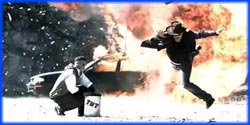


Premier Date: April 8, 2009
busted
In their initial test, Adam and Jamie placed several water-filled barrels inside a bus to match the weight of the nineteen passengers seen in the film. They first placed all of the barrels on the right side of the bus and performed a right hand turn at 50 miles per hour. The bus struggled to make the turn but did not flip over. Next, they performed a second turn with the weight evenly distributed, and the bus still did not flip, busting the myth. In order to flip the bus, Adam and Jamie distributed all of the weight to the outside of the bus to shift its center of gravity, added steel weights to the roof to make it top heavy, and deflated the left side air-suspension to further shift the weight of the vehicle.
(This myth is inspired by a scene in the movie Speed.)
busted
The car completely demolished the fruit stand, and was no longer drivable because the of a crushed front end.
plausible
The car successfully crashed through the gate. Despite suffered severe damage, the car was still drivable, prompting the Build Team to declare this myth plausible.
busted
The car completely demolished the trailer, rather than making the clean hole seen in movies. The car itself was also completely destroyed in the crash.
plausible
The trailer tore the roof off of the car, making it an instant convertible. However, the car’s braking system failed and it continued on, uncontrollably driving off an earthen berm and going airborne. Based on video playback, the car looked as if it was still in drivable condition after driving under the trailer, prompting a plausible result.
busted
The Build Team first dropped a car from a crane to see how it would behave in free fall. However, they found that unlike the commercial, the car would not fall upright and would instead hit the ground front-first. They solved this problem by evenly distributing the weight of the car. For the actual test, the Build Team dropped a car from a helicopter while a remote controlled car drove at 140 miles per hour (225 km/h) in an attempt to beat it. However, because the car on the ground could only achieve a top speed of 105 miles per hour (169 km/h), the Build Team had to shorten the ground distance to 2,950 feet (900 m) to compensate. Despite this, the falling car still managed to beat the ground car. These factors prompted the Build Team to declare the myth busted.
busted
In their first attempt several years ago, the MythBusters had technical difficulties testing this myth. This time, the MythBusters rebuilt the entire crash rig. The test was successful, with both trucks crashing head-on and simultaneously with the compact car. However, the compact car was pushed out of the collision zone rather than staying between the trucks, and the trucks were not fused together as stated in the myth. In order to see what it would take to pancake and fuse a compact, the MythBusters decided to ram a compact car with a rocket sled. The rocket sled struck the compact car at a speed of 648 miles per hour (1,043 km/h), completely disintegrating it. Nonetheless, the impact didn’t achieve the fusion they were looking for. In order to see what it would take to fuse two pieces of metal together, the MythBusters demonstrated explosion welding where metal could be fused by using high explosives. Since trucks cannot travel faster than sound, nor can high explosives be easily found on a highway, the myth was ultimately busted.